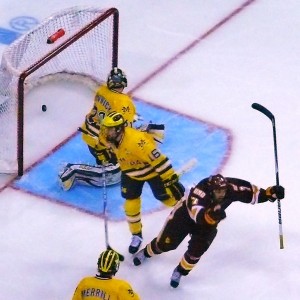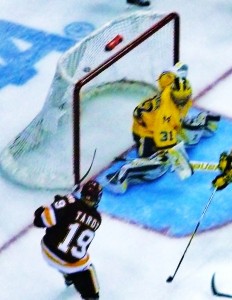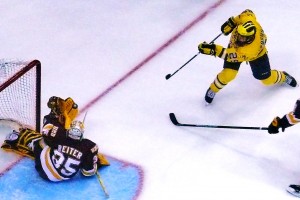Schmidt’s OT goal gives UMD NCAA title

Kyle Schmidt scored the overtime game-winner for UMD's 3-2 victory over Michigan, and immediately skated the length of the ice to celebrate.
By John Gilbert
Kyle Schmidt found the perfect ending to his Minnesota-Duluth hockey career, scoring at 3:22 of sudden-death overtime Saturday night to give the Bulldogs a 3-2 victory over Michigan. It was Schmidt’s 11th goal of the season, the biggest goal of his life, and the biggest goal in the 50-year history of UMD hockey, because it came in front of 19,222 fans at Xcel Energy Center and gave the Bulldogs the first NCAA Division I men’s hockey championship in program history.
Schmidt, a senior from the Duluth suburb of Hermantown, has not always had great timing this season. He broke his hand in practice the day before UMD played its ceremonial first game at its new AMSOIL Arena in Duluth, and he was later injured during the East Regional. But he overcame all the adversity and played well enough to regain his spot on the second line and be presented with the National Unsung Hero award, given each year to a good player and dedicated worker, but also someone who has not been a heavily publicized star.
Schmidt fouled that up, pretty thoroughly when he skated in from the right side to score with a pass from Travis Oleksuk behind the net. As heroes go, Schmidt instantly went from unsung to “sung.”
It was a night for unsung heroes, as UMD’s high-powered first line was held off the scoresheet by Michigan’s hustling and persistent Wolverines. Oleksuk and Schmidt picked up the slack with goals for the second line, and lightly used freshman fourth-line center Max Tardy scored his first collegiate goal on the backup power-play unit. Michigan got into the spirit of the night too, taking a 1-0 lead on Ben Winnette’s first-period goal, and tying the game 2-2 when fourth-line center Jeff Rohrkemper scored late in the second period for the 2-2 deadlock.
“That’s what often happens in a game like this,” said Michigan coach Red Berenson. “The top players just about neutralize each other, and usually an unsung guy gets the big goal.”
Michigan (29-11-4) was making a bid for its 10th NCAA championship and third in Berenson’s 27-year coaching career. His two titles were both won by 3-2, for good measure. But the CCHA champions didn’t intimidate the Bulldogs (26-10-6), who played with the confidence they have maintained while establishing a remarkable 7-2-6 record in overtime games this season.
“I’m so extremely proud of this team,” said UMD coach Scott Sandelin. “Not just for the players, but for the alumni, the city. I’m just excited for these players to have this experience.”
There also was some further kharma going for Schmidt, was the only player who didn’t dye his hair the outrageous bleach-blond his teammates decided to use for team playoff unity. His teammates didn’t seem to mind, and they definitely didn’t mind after Schmidt ended Saturday night’s game. At the post game press conference, someone asked if leaving his hair its natural color was responsible for scoring his game-winner. Schmidt paused and then deadpanned: “Yes.”
Schmidt is getting married in a few weeks and his fiance didn’t want him fouling up any wedding pictures by looking like a latter-day beach boy.
The Bulldogs outshot Michigan 38-24, but never had the upper hand against the tenacious Wolverines, who are almost an annual fixture in NCAA tournament time. “Good for Minnesota-Duluth,” said Berenson. “They were a better team than we thought during the season. They were kind of under the radar. I thought our penalty-killers were dialed in, and they have they have a terrific power play — the best we’ve seen all year.”
Berenson was not impressed with the officiating of Eastern referees Tim Benedetto and Jeff Bunyon, who gave Michigan nine penalties to four for UMD. “Every time somebody falls down there doesn’t have to be a penalty,” Berenson said.
As higher seed, Berenson had last change and started his veteran defensive line, with Matt Rust centering fellow senior Ben Winnett and junior Luke Glendening. Even counting Winett’s fourth goal of the season, the game-winner in the 2-0 semifinal shutout over North Dakota, the three linemates came into the final with a total of 17 goals — fewer than any of the players on UMD’s top line — Jack Connolly with 18 goals, Mike Connolly with 28 and Justin Fontaine with 22. But with Winett scoring his fifth goal in the final, the checkers outscored the checkees.
The closest UMD’s top unit came to scoring was a power-play blast from the right side by Jack Connolly that rang the short-side right post. Shortly after that, Michigan appeared to score, when Carl Hagelin poked a rebound from under goaltender Kenny Reiter, who had been sitting on it for a couple of seconds, but the ECAC referees waved it off for coming after the whistle.
At 14:42 of the opening period, the Wolverine succeeded in their role-swapping, when Rust won a left-corner faceoff back to Winnett, who skated to the slot and shot off defenseman Justin Faulk’s skate and into the left edge of the net for a 1-0 lead.
It wasn’t until the second period that UMD’s second line proved it was possible to get a puck past Michigan goaltender Shawn Hunwick, whose semifinal shutout had subdued North Dakota. T.J. Brown slid the puck out to the right point, where Brady Lamb faked a shot, stepped in and shot, with Oleksuk knocking in the rebound from the right edge to tie the game 1-1 at 1:39 of the second period.
The Bulldogs finally clicked on their fourth power play to gain a 2-1 lead, but it was after the first unit had gone to the bench. Tardy, recently plugged into the lineup because of his puck-handling prowess, was in the left corner for a pass from Lamb, who assisted on all three UMD goals. Tardy stepped out and tried to pass across the goal-mouth, but Hunwick blocked the pass right back to Tardy, who deposited it into the net at 9:31.
“I just tried to stay calm, like we were playing shinny hockey, and it worked out,” said Tardy. “It’s a tremendous feeling to be part of the first UMD team to bring home the championship.”
A flurry of penalties had been settled up later in the second period, and just after a power play ended, the Wolverines got the 2-2 tie. Greg Pateryn’s hard shot from the left point hit Jack Connolly squarely in the foot, dropping him to the ice. In the ensuing scramble, Rohrkemper got the loose puck and snapped a backhander into the left edge of the net with 2:14 remaining in the second period.
Both sides had their chances in the scoreless third period, highlighted by J.T. Brown making a couple of rink-length rushes that showed he still had some energy flowing while everybody else seemed to be wearing down from the high-speed pace. One of those dashes came after the faceoff following a penalty to Lamb, and when Brown sped around the Michigan defense, Jon Merrill had to tackle Brown to prevent a shorthanded goal, earning a penalty that negated the power play after only eight seconds. For his high-intensity game, Brown was named the outstanding player of the Frozen Four, and joined Schmidt and defenseman Faulk on the all-tournament team, along with Winett, Merrill, and goaltender Hunwick.
UMD outshot the Wolverines 9-6 in the third period, and 38-24 for the game. But this was a game that deserved to be settled in overtime, and both Hunwick and Reiter made sure it got there. Then, as Berenson mentioned, it came down to a one-shot game, and the shot heard ’round the hockey world was taken by Kyle Schmidt.
Comments
Tell me what you're thinking...
and oh, if you want a pic to show with your comment, go get a gravatar!




 John Gilbert is a lifetime Minnesotan and career journalist, specializing in cars and sports during and since spending 30 years at the Minneapolis Tribune, now the Star Tribune. More recently, he has continued translating the high-tech world of autos and sharing his passionate insights as a freelance writer/photographer/broadcaster. A member of the prestigious North American Car and Truck of the Year jury since 1993. John can be heard Monday-Friday from 9-11am on 610 KDAL(www.kdal610.com) on the "John Gilbert Show," and writes a column in the Duluth Reader.
John Gilbert is a lifetime Minnesotan and career journalist, specializing in cars and sports during and since spending 30 years at the Minneapolis Tribune, now the Star Tribune. More recently, he has continued translating the high-tech world of autos and sharing his passionate insights as a freelance writer/photographer/broadcaster. A member of the prestigious North American Car and Truck of the Year jury since 1993. John can be heard Monday-Friday from 9-11am on 610 KDAL(www.kdal610.com) on the "John Gilbert Show," and writes a column in the Duluth Reader.